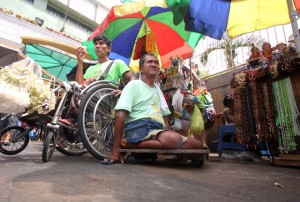Described as a “complete enumeration” of the entire Philippine population, the 2015 Census has ignored crucial data on a significant sector: persons with disabilities (PWD).
The exclusion of questions on disability in the August census does not only leave out a group already lamenting its invisibility in society, but it could also have consequences for the country’s overall development agenda.
“It’s an outright denial of the rights of persons with disabilities to be counted,” said a fuming Carmen Zubiaga, National Council on Disability Affairs (NCDA) Acting Executive Director.
The leaders of the Asia Pacific Economic Cooperation (APEC) who met in Manila included PWDs in their declaration, saying they “recognize the significance of enabling the full participation of all sectors and segments of our society.”
PWDs are mentioned thrice in the 2015 declaration, which capped the recently concluded APEC Economic Leaders Meeting (AELM).
“I am personally so disappointed with the Philippine Statistics Authority (PSA) for not consulting (PWDs) or even NCDA for the 2015 census,” Zubiaga said.
Sought for comment, PSA only said, “(The) main objective of the 2015 Census of Population (POPCEN 2015) is to update the population count. Question on disability will be included in the 2020 Census of Population and Housing (2020 CPH).”
Yet, this runs counter to what the PSA itself says on its website as the main goal of the exercise: not to simply count the population but to provide useful data.
“The POPCEN 2015 aims to provide government executives, policy and decision makers, and planners with population data, especially updated population counts of all barangays in the country, on which to base their social and economic development plans, policies, and programs,” the PSA census primer reads.
Specifically, the primer lists the usefulness of data for the government in formulating “policies concerning various segments of the population (children, youth, elderly, women of reproductive age, voting age, and working age)” as well as “policies and programs relative to the delivery of basic services, such as on health, education, employment, housing, infrastructure, disaster relief, and other socio-economic concerns.”
PSA did not respond to further follow-up questions, but did provide copies of the basic questionnaire it used in the 2015 census.
The form gathers information on names of household members, relationship to the household head, sex, date of birth, age, birth registration, marital status, religious affiliation, school attendance, literacy, highest grade/year completed, technical/ vocational course obtained, if overseas worker or not, and usual activity/ occupation.
Housing questions include type of building, construction materials of the roof of the building and outer walls of the building/ housing unit, fuel for lighting, source of water supply for drinking and cooking, and tenure status of the housing unit/ lot.
Also included are questions on registration of deaths in the last two years among household members.
The non-inclusion of disability questions in the census would make the country remiss in its obligation as a signatory to the United Nations Convention on the Rights of PWDs (UNCRPD).
Article 31 of the CRPD directs state parties to “collect appropriate information, including statistical and research data” on disability.
As a UN member state, the Philippines is also bound by the sustainable development goals (SDGs), launched this year to replace the expired millennium development goals (MDGs).
Seven SDG targets on education and employment explicitly refer to PWDs.
“The seven targets mentioning disability must be monitored with specific disability indicators or by disaggregating indicators by disability,” noted the UNCRPD Secretariat.
Lack of data at the national level “contributes to the invisibility of persons with disabilities in official statistics, presenting an obstacle to achieving development planning and implementation that is inclusive of persons with disabilities,” it said.
The Washington Group on Disability Statistics, formed in 2001 and operating under the UN Statistical Commission, has developed a set of six questions which can be included in national census and surveys to collect data on PWDs.
The questions ask if a person has difficulty seeing, even if wearing glasses; difficulty hearing, even if using a hearing aid; difficulty walking or climbing steps; difficulty remembering or concentrating; difficulty with self-care such as washing all over or dressing; and difficulty communicating, for example understanding or being understood, using his or her usual or customary language.
These questions are intended make data internationally comparable.
The Philippines is not among the countries listed by the CRPD Secretariat as having included Washington Group questions in their last census. Southeast Asian neighbors that have done so include Indonesia (2010), Timor-Leste (2010) and Vietnam (2009).
Disability questions, however, have been included in previous censuses in the country. Results of the 2010 census show that of the 92.1 million household population, 1.57 percent or some 1.4 million persons had disability.
Calabarzon had the highest number of PWDs (193,000) followed by the National Capital Region (167,000). The region with the lowest number was the Cordillera Administrative Region (26,000).
There were more males (50.9 percent of the total) than females (49.1 percent) with disabilities. Disability was highest among Filipinos aged 5 to 19 years.
The total number of PWDs based on the 2010 census showed an increase from the 942,098 PWDs counted during the 2000 census. The 1995 census had an even lower number of PWDs at 919,292.
Results of the 2015 census will see a staggered release starting the last quarter of 2016.
Whether PSA did the census right or not, Zubiaga said, “The only thing that matters is the inclusion of disability in all national initiatives.”
“We also want to remind PSA that they have to declare how they spent their budget on disability based on Section 34 of the General Appropriations Act,” she said.
That section of the national budget mandates a 1 percent allotment in the budgets of agencies for projects that address the needs of PWDs and senior citizens.
“(PWDs) are lamenting this act of excluding disability in the 2015 census,” Zubiaga said.
(VERA Files is put out by veteran journalists taking a deeper look into current issues. Vera is Latin for “true.”)


